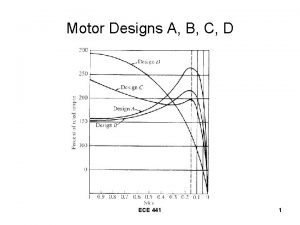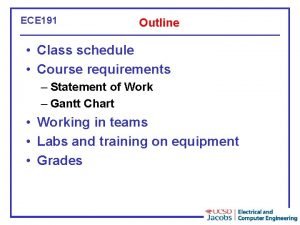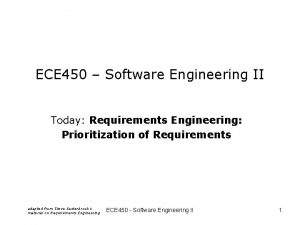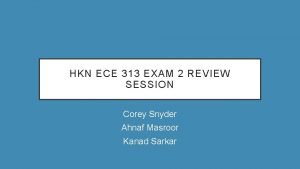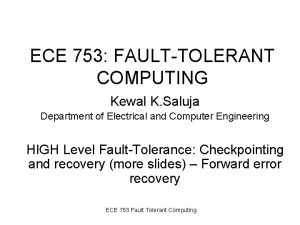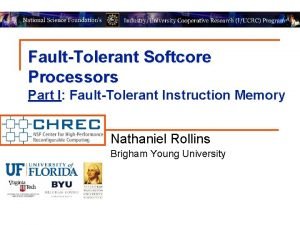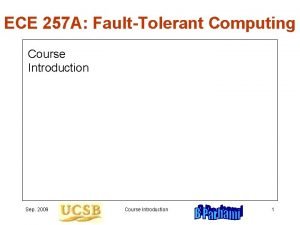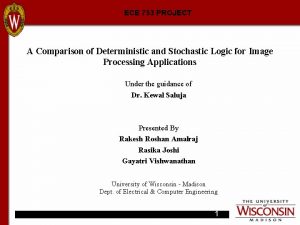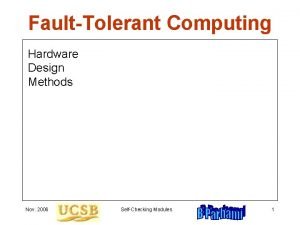ECE 753 FAULTTOLERANT COMPUTING Kewal K Saluja Department



![Introduction • References • [prad: 96] • [john: 89] • [triv: 82] These three Introduction • References • [prad: 96] • [john: 89] • [triv: 82] These three](https://slidetodoc.com/presentation_image/9a936d5dc79db2d5cc7be7cabd035b68/image-4.jpg)
























- Slides: 28

ECE 753: FAULT-TOLERANT COMPUTING Kewal K. Saluja Department of Electrical and Computer Engineering Reliability Modeling and Analysis Lectures 8 -10 ECE 753 Fault Tolerant Computing

Overview • Recap • Introduction • Reliability Modeling – reliability block diagram – combinatorial model – Markov model • Other Parameters and analysis • General remarks and Summary ECE 753 Fault Tolerant Computing 2

Recap • Course introduction • Fundamental principles - Four types of redundancy • FEF and breaking FEF chain • Fault modeling – models at different levels, error models, process failure models • Testing and Test Generation – test generation, fault simulation, DFT and BIST concepts • Simple concepts in fault-tolerance – hardware redundancy, information redundancy, time redundancy, and software redundancy methods ECE 753 Fault Tolerant Computing 3
![Introduction References prad 96 john 89 triv 82 These three Introduction • References • [prad: 96] • [john: 89] • [triv: 82] These three](https://slidetodoc.com/presentation_image/9a936d5dc79db2d5cc7be7cabd035b68/image-4.jpg)
Introduction • References • [prad: 96] • [john: 89] • [triv: 82] These three books contain sufficient material covering this part of the course • Recap of definitions • Importance of analysis and analytical model • Mathematical formulation for quantitative analysis ECE 753 Fault Tolerant Computing 4

Introduction (contd. ) • Recap of definitions – Reliability R(t) – Availability A(t) – Performability and Dependability • Importance of analysis and analytical model – – – to evaluate a design a metric to compare different designs to provide feedback to the designer during early design stages use a model for performance analysis used for quantitative and qualitative analysis ECE 753 Fault Tolerant Computing 5

Introduction (contd. ) • Mathematical formulation for quantitative analysis – consider a large experiment with N systems – observation at time t • N 0(t) - number of correctly operating systems • Nf(t) - number of failed systems – Hence • • Reliability R(t) = N 0(t)/N(t) = 1 - Nf(t)/N Unreliability Q(t) = 1 - R(t) Derivative of reliability: d. R/dt = -(1/N)(d. Nf(t)/dt) d. Nf(t)/dt is called instantaneous failure rate of the component ECE 753 Fault Tolerant Computing 6

Introduction (contd. ) • Mathematical formulation (contd. ) – Also • failure rate at time t – (instantaneous failure rate at time t) / N 0(t) – (1/No(t))(d. Nf(t)/dt) - called z(t) – this and the previous expressions together reduce to » z(t) = -(1/R(t))(d. R(t)/dt) » Z(t) is called failure rate, hazard function or hazard rate – We can solve the above for R(t) provided we know instantaneous failure rate – Bath tub curve for failure rate » implies constant failure rate during useful life » infant mortality and wear out periods have variable failure rates ECE 753 Fault Tolerant Computing 7

Introduction (contd. ) • Mathematical formulation (contd. ) – Reliability computation - constant failure rate • solve the equations - exponential function for reliability and for unreliability, R(t) = 1 - Q(t) = exp(-λt) – Reliability computation - time varying failure rate • Waibull distribution z(t) = αλ(λt)**(α-1) • solve the equations - exponential function for reliability and for unreliability – Failure rate computation - military standard • function of - learning factor, quality factor, temperature factor, environmental factor, and # of pins on IC ECE 753 Fault Tolerant Computing 8

Introduction (contd. ) • Mathematical formulation (contd. ) – Reliability computation - mean time to failure (MTTF) • Definition: expected time that a system will operate before the first failure occurs • Probability measure: S-sample space, E-event space – for A in E P(A) >= 0 – P(S) = 1 – P(A B) = P(A) + P(B), when A and B are non-intersecting • Random Variable (RV) - X maps events of S to real-numbers • Probability distribution function of a RV • Probability density function (pdf) - derivative of the distribution function ECE 753 Fault Tolerant Computing 9

Introduction (contd. ) • Mathematical formulation (contd. ) – Reliability computation - mean time to failure • Probability density function - properties – always >= 0 – integrates to 1 (between limits) • Expectation – Integrate xf(x) – Σ xi p(xi) in discrete case • Application in our case – unreliability Q(t) is a probability distribution function of failure in fact it is cumulative probability that system fails in time [0, t] ECE 753 Fault Tolerant Computing 10

Introduction (contd. ) • Mathematical formulation (contd. ) – Reliability computation - MTTF and MTTR • Application in our case (contd. ) – derivative of Q(t) , written as f(t), is pdf of failure - or failure density function – Expected value can be computed using integration and is Mean Time To Failure (MTTF) – constant failure rate » MTTF = 1/λ • Mean time to repair - MTTR – assume constant repair rate (μ) and arguments similar to those used for failure analysis and conclude MTTR = 1/ μ ECE 753 Fault Tolerant Computing 11

Introduction (contd. ) • Mathematical formulation (contd. ) – Reliability computation - mean time between failure (MTBF) • Mean time between failure - MTBF – use heuristic arguments to conclude » MTBF = (total time T)/(average number of failures) – can also argue MTBF = MTTF + MTTR • Note: often λ << μ and hence MTTF >> MTTR , therefore the words MTTF and MTBF are used interchangeably by some practioners ECE 753 Fault Tolerant Computing 12

Reliability Modeling • Application of the previous analysis to system models – Assumptions • system consists of modules • each module assigned a probability of working R(t), a function of time • once a module fails it is assumed to yield incorrect results • module failures are independent ECE 753 Fault Tolerant Computing 13

Reliability Modeling • Application of the previous analysis to system models – Reliability block diagrams • consider a system - micro. P, controller, mem, bus, … • the system will fail if any of the components fails • Rsys = P(all subsystems work correctly) = P(bus correct). P(mem correct)…. Etc. (follows from the assumption that component failures are independent) • Rsys = Rbus. Rmem. Rmicro. Rcont ECE 753 Fault Tolerant Computing 14

Reliability Modeling – Reliability block diagrams - Series Systems • Assume system has n components • All components should survive for system to operate • Reliability of system – R sys = Pi Ri (t) • For exponential distributions of each component – R sys = Pi e - l i t = e - (l 1 + l 2 +. . . + ln)t =exp(- Slit) – Effect is that the system failure rate is the summation of failure rates of components • Note these are nonredundant systems R 1 R 2 ECE 753 Fault Tolerant Computing Rn 15

Reliability Modeling – Reliability block diagrams - Parallel Systems • Assume system with spares • faulty component is replaced by a spare as fault occurs • only one component needs to survive for the system to operate • Model is to represent all components connected in parallel • P(sys fail) = P(M 1 fails). P(M 2 fails). . P(Mn fails) • Rsys = 1 - P(sys fail) = 1 - (1 -R 1)(1 -R 2) …(1 -Rn) ECE 753 Fault Tolerant Computing 16

Reliability Modeling – Reliability block diagrams - Series-Parallel Systems • straight forward – Reliability block diagrams - MTTF of system • 1/(system failure rate) • Series systems - 1/(sum of individual falure rates) • Parallel systems and series parallel systems – work out by integration from the reliability or unreliability equations ECE 753 Fault Tolerant Computing 17

Reliability Modeling – Reliability block diagrams -Non series parallel systems • Bayes rule: consider a sample space S. Partitions this into space B and B (complement of B). Now consider an event that falls partly in B and partly in B. We can write: A = (A B) P(A) = P[(A B)] = P[(A B)] + P[(A B)] = P(A/B)P(B) + P(A/ B)P( B) • In general the set S can be partitioned into (B 1, B 2, … , Bn) P(A) = Σ P(A/Bi)P(Bi) This can be viewed graphically also (draw a tree) ECE 753 Fault Tolerant Computing 18

Reliability Modeling • Reliability block diagrams -Non series parallel systems – Example - consider the following non series parallel system – list all paths for system to survive, namely c 1 c 4, c 2 c 5, c 3 c 5 – These paths are not disjoint, sum of reliabilities of all path gives an upper bound on the system reliability – Exact computation is possible using Bayes rule – complete in class C 1 C 4 C 2 C 3 ECE 753 Fault Tolerant Computing C 5 19

Reliability Modeling – Combinatorial model • Consider an NMR system • Assume voter reliability to be 1 • Divide all events for success to disjointed events • Compute probability of each event and add them • Example – TMR system • Can be used to compute MTTF • Can also analyze other systems such as an m-of-n system ECE 753 Fault Tolerant Computing 20

Reliability Modeling – Markov model • Difficulty with the previous models – incorporating repairs in the model and analysis – Incorporation of coverage factor – such as in duplicates system we may be less than 100% certain that only faulty unit will be eliminated when system is re-configured • Markov modeling - basic – Define the concept of state using TMR system example (8 states) – Transitions between states occur with certain probabilities • Markov model – assumption – Probability of transition from a state si to sj is independent of the method of arrival into state si • Example – develop a Markov model for a TMR in class ECE 753 Fault Tolerant Computing 21

Reliability Modeling – Markov model • Markov model for a TMR – all details not shown 011 001 λΔt 1 -3λΔt 111 000 λΔt 101 010 100 λΔt ECE 753 Fault Tolerant Computing 22

Reliability Modeling – Markov model- Reduced • Reduced Markov model for a TMR system • Previous eight state model can be reduced to a three state model by merging states and re-computing the transition probabilities – Markov model- accounting for repairs • We can include links between states knowing the repair rates of components ECE 753 Fault Tolerant Computing 23

Reliability Modeling – Markov model- analyzing systems • Consider a duplicate compare system – no repairs • Develop Markov model with 3 states • Develop a difference equation for computing probabilities for being in different states of the system • Develop a differential equation model • Solution methods – Numerical approach – Solving differential equation » direct approach » Using Laplace transforms ECE 753 Fault Tolerant Computing 24

Reliability Modeling – Markov model- analyzing systems • • Consider a duplicate compare system – with Develop Markov model with 3 states Develop a differential equation model Solve using Laplace transforms repairs – Yet one more example • duplicate compare system – with imperfect coverage • Develop Markov model with 5 states • Reduce model for different scenarios ECE 753 Fault Tolerant Computing 25

Other Parameters and analysis – Markov model- Can use other parameters • Safety – • Availability – Consider a simplex system – Develop Markov model with 2 states – Solve the system for probability of system being in available state – Define and compute steady state availability – Provide a intuitive explanation of the computed value of steady state availability and its relation of MTTF and MTTR • Maintainability ECE 753 Fault Tolerant Computing 26

General remarks – Voter reliability issue – Performance and states with degraded performance – Mission time improvement – Redundancy Ratio – Law of diminishing return ECE 753 Fault Tolerant Computing 27

Summary • Introduction of mathematical models • Solving models to carry out analysis – Example systems • Duplicate with repair • Simplex with repair for avialability ECE 753 Fault Tolerant Computing 28
 Sumit saluja
Sumit saluja Stipta
Stipta 753 v chr
753 v chr 753-510 a.c
753-510 a.c 753-509 a.c
753-509 a.c Who founded rome in 753 bc
Who founded rome in 753 bc 753bc
753bc 753-509
753-509 Patriciji i plebejci
Patriciji i plebejci Estimate word problems
Estimate word problems Who founded rome in 753 bc
Who founded rome in 753 bc Cs flowchart wpi
Cs flowchart wpi Conventional computing and intelligent computing
Conventional computing and intelligent computing Workforce registry ca
Workforce registry ca Ece 430
Ece 430 Uiuc cs 461
Uiuc cs 461 Come muoversi a bordeaux
Come muoversi a bordeaux Ece 651
Ece 651 Electrical engineering umd
Electrical engineering umd Selin aviyente
Selin aviyente Ece
Ece Ece 191
Ece 191 Ece 627
Ece 627 Ece 445
Ece 445 Ece 450
Ece 450 Ece ulukal karancı
Ece ulukal karancı Ece 695
Ece 695 Ece 3130
Ece 3130 Hkn review session
Hkn review session




















